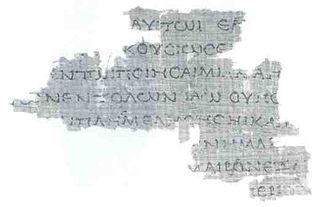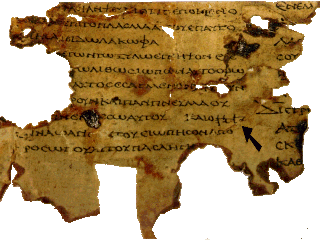Related Research Articles

Papyrus 46, designated by siglum 𝔓46, is an early Greek New Testament manuscript written on papyrus, and is one of the manuscripts comprising the Chester Beatty Papyri. Manuscripts among the Chester Beatty Papyri have had several provenances associated with them, the most likely being the Faiyum. It has been paleographically dated between 175 and 225, or early 3rd century CE. It contains verses from the Pauline Epistles of Romans, 1 Corinthians, 2 Corinthians, Galatians, Ephesians, Colossians, Philippians, 1 Thessalonians, and Hebrews. Some leaves are part of the Chester Beatty Biblical Papyri, and others are in the University of Michigan Papyrus Collection.
In contrast to the variety of absolute or personal names of God in the Old Testament, the New Testament uses only two, according to the International Standard Bible Encyclopaedia. From the 20th century onwards, "a number of scholars find various evidence for the name [YHWH or related form] in the New Testament.

In Christian scribal practice, nomina sacra is the abbreviation of several frequently occurring divine names or titles, especially in Greek manuscripts of the Bible. A nomen sacrum consists of two or more letters from the original word spanned by an overline.

The Tetragrammaton, or the Tetragram, is the four-letter Hebrew theonym יהוה, the name of God in the Hebrew Bible. The four letters, written and read from right to left, are yodh, he, waw, and he. The name may be derived from a verb that means "to be", "to exist", "to cause to become", or "to come to pass". While there is no consensus about the structure and etymology of the name, the form Yahweh is now accepted almost universally, though the vocalization Jehovah continues to have wide usage.
Papyrus 91, is an early copy of the New Testament in Greek. It is a papyrus manuscript of the Acts of Apostles. The surviving texts of Acts are verses 2:30-37; 2:46-3:2. The manuscript paleographically has been assigned to the middle of the 3rd century.

Papyrus Rylands 458 is a manuscript of the Pentateuch in the Greek Septuagint version of the Hebrew Bible. It is a roll made from papyrus, which has survived in a very fragmentary condition. It is designated by the number 957 on the list of Septuagint manuscripts according to the numbering system devised by biblical scholar Alfred Rahlfs. Using the study of comparative writing styles (palaeography), the manuscript has been dated to the middle of the 2nd century BCE.

The Papyrus Fouad 266 are fragments, part of a papyrus manuscript in scroll form containing the Greek translation, known as the Septuagint, of the Pentateuch. They have been assigned palaeographically to the 1st century BCE. There is discussion about whether the text is original or a later recension of the Septuagint.
Papyrus Oxyrhynchus 654 is a papyrus fragment of the logia of Jesus written in Greek. It is one of the Oxyrhynchus Papyri discovered by Grenfell and Hunt between 1897 and 1904 in the Egyptian town of Oxyrhynchus. The fragment is dated to the middle or late of the 3rd century. It is one of only three Greek manuscripts of the Gospel of Thomas.

The manuscript 4Q120 is a Septuagint manuscript (LXX) of the biblical Book of Leviticus written on papyrus, found at Qumran. The Rahlfs-No. is 802. Paleographically it dates from the first century BCE. Currently the manuscript is housed in the Rockefeller Museum in Jerusalem.

Papyrus Oxyrhynchus 1007 is a fragment of a Greek Septuagint manuscript written on parchment. The manuscript was discovered in Oxyrhynchus, modern El-Bahnasa, Egypt. Using the study of comparative writing styles (palaeography), the manuscript has been dated to the 3rd century CE.

The Greek Minor Prophets Scroll from Nahal Hever is a Greek manuscript of a revision of the Septuagint dated to the 1st century BC and the 1st century CE. The manuscript is kept in the Rockefeller Museum in Jerusalem. It was first published by Dominique Barthélemy in 1963. The Rahlfs-Siglum is 943.

Papyrus Oxyrhynchus 5101, designated by 2227, or P.Oxy.77 (LXXVII) 5101, is a manuscript of the Greek Septuagint Psalms, written on papyrus in roll form. It has survived in a very fragmentary condition. Using the study of comparative writings styles (palaeography), it has been dated to the middle of the first - middle of the second century CE.

The AqBurkitt are fragments of a palimpsest containing a portion of the Books of Kings from Aquila's translation of the Hebrew bible from the 6th century, overwritten by some liturgical poems of Yanai dating from the 9–11th century. This Aquila translation was performed approximately in the early or mid-second century C.E. The manuscript is variously dated to the 6th-century CE, or 5th-6th century CE.

Papyrus Oxyrhynchus 656 – is a Greek fragment of a Septuagint manuscript written on papyrus in codex form. This is a manuscript discovered at Oxyrhynchus, and it has been catalogued with number 656. Palaeographycally it is dated to late second century or early third century.

The Washington Manuscript of the Psalms, designated as Rahlfs 1219, van Haelst 83, is a Greek Septuagint manuscript containing the text of Psalm 1:4-146:9a, 149:2b-151:6, plus the first 6 verses of the book of Odes, written on parchment which has survived in a fragmentary condition. Using the study of comparative writing styles (palaeography), it has been assigned to the 5th Century CE.
Papyrus Oxyrhynchus 4443 is a fragment of a Septuagint manuscript (LXX) written on papyrus in scroll form. It is the oldest extant manuscript that contains Esther 8:16–9:3 of the Septuagint text and verse numbering, according to the text of LXX. The manuscript has been assigned palaeographically to 50–150 CE.
The Papyrus Deissmann is a septuagint manuscript written in papyrus that contains parts of the Book of Exodus. Using the study of comparative writing styles (palaeography), it has been dated to 3rd-century. Currently is kept at Armidale, Private collection, Australia.

The Papyrus Chester Beatty VI are fragments of a papyrus manuscript of the Greek Septuagint and one of the Chester Beatty papyri. It contains parts of the Book of Numbers and Deuteronomy. Using the study of comparative writing styles (palaeography), it has been dated to 200 CE.
The Papyrus Leipzig Inv. 170 is a fragment of a septuagint manuscript written on papyrus in codex form that contains part of the Psalms. Palaeographically it has been dated to the 3rd century CE.
The Papyrus Chester Beatty VIII is a fragment of a septuagint manuscript that contains parts of the biblical Book of Jeremiah. Palaeographically it has been dated to the late second, early third century CE.
References
- ↑ Zachary Cole (2017). "6. Numerals in Manuscripts of the Greek Old Testament". Numerals in Early Greek New Testament Manuscripts: Text-Critical, Scribal, and Theological Studies. BRILL. p. 164. ISBN 9789004343757.
- ↑ Jennifer R. Strawbridge (March 2011) How Present is Romans in Early Christian School Exercises: Is P. Lond. Lit 207 Mislabelled? in Oxford Research Archive.
- ↑ Didier Fontaine, (2012) Le P52 contenait-il un nomen sacrum pour «Jésus»?
- ↑ Don C. Baker (2007). "A.2. P.Lond.Lit. 207 and the origin of the nomina sacra: a tentative proposal" (PDF). Studia Humaniora Tartuensia. 8: 1–14. ISSN 1406-6203.
- ↑ TM 62310 / LDAB 3473